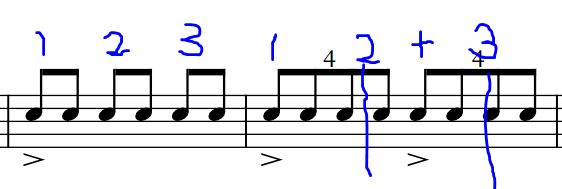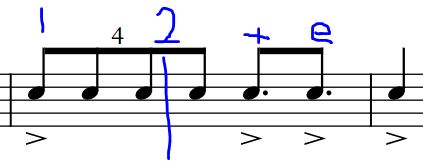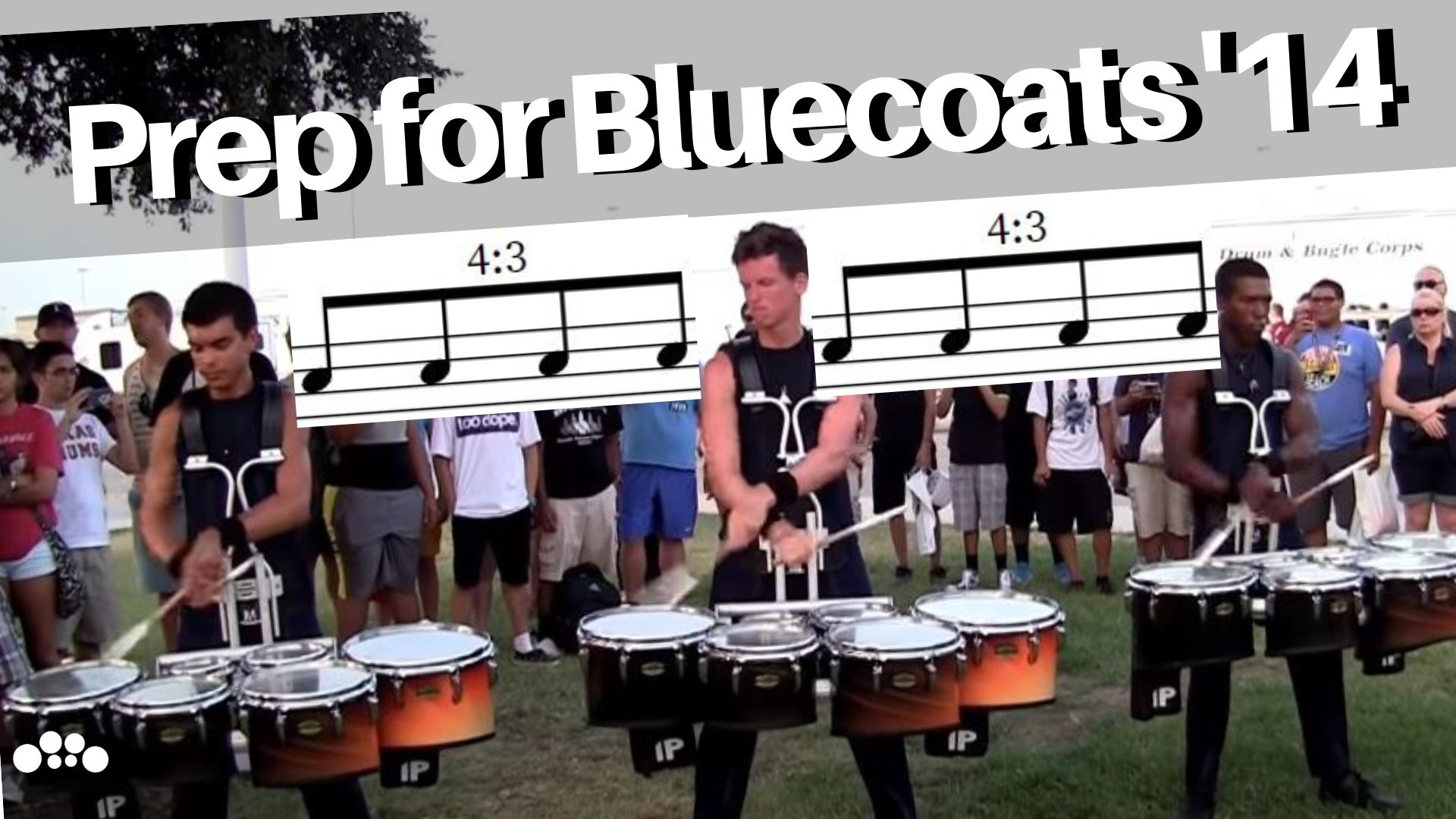Before diving into a crazy Bluecoats lick, let’s take a close look at how to play the 4:3, or 4 over 3, or 4 against 3 pattern. This rhythmic interpretation is sprinkled heavily throughout the drum feature. At just a shade slower than triplets, the difference is subtle, but this exemplifies the line’s attention to rhythmic detail.
As always, it is extremely important to break down difficult passages, and establish a strong foundation before adding in all the embellishments. So, I wrote a short exercise to do just that.
4:3 is not that bad
First, to show that this is a subdivision you can handle, I want you to play this:

Guess what? This sounds EXACTLY the same as this:

The only difference is how often the metronome clicks. If you had headphones connected to the metronome, someone listening would not be able to tell the difference. Except for a couple extra accents, this is the first line of the exercise.
You Need to Mark Time to This
I don’t mention this in the video, but it is SOOOOO important that you are marking time to this. In general, I would say it’s almost more important to be able to play to your feet than a metronome (I know, I’ll probably hear about it for that).
I find that if you remove all unnecessary variables, sticks, drum, metronome, and just sit on the couch with your hands on your thighs, you can really ingrain this pattern into your hands and feet.
For the rest of this lesson, assume you should be marking time, the entire time!
Moving on…
4:3 Line One
Humor me and play the first two measures of line one at around 100bpm. This is just to get a feel for the tempo and establish our eighth notes. Now, looking at the first half of measure three, we have our 4:3 pattern.

Note that we are in 3/4 time here, so that group of 4 notes is over a count and a half. By turning on the eighth notes on your metronome (or double the tempo), we can make sure our release lines up right on the “+” of count two.

Practice the first three and a half measures, stopping on the “+” of two. Adjust the speed of the 4:3 until your release is consistently lining up perfectly with your metronome. When that is comfortable, add the rest of measure three.
After you can get through measure three perfectly over and over (listen for the “+” of two and the downbeat of measure four), then go ahead and try the whole line. Adjust your speed as necessary and listen for those checkpoints.
4:3 Line Two
The second line is the same as the first except each pattern is half as long.

Since we are in 3/4, our feel will alternate on count one of each measure (measure one off left, measure two off right). Use these to help you with the rhythmic checkpoints. You don’t have too much time to get used to each subdivision here, so hopefully you locked in the speed change in line one.
4:3 Line Three
Now we get into a pattern that’s taken right out of the tenor solo portion of the Bluecoats 2014 drum feature. As you can see, it starts off not too bad, but we get thrown for a loop in the third measure.

In measure two, our 4:3 pattern starts on the “+” of count two and releases on the downbeat of measure three. Then, we start another 4:3 group on the “+” of one, releasing on count three.

This is a tricky pattern, and one we will need for the actual lick, so take it as slow as you need to until all of those check points are lining up. I suggest playing along with me in the video to make sure you’re getting the interpretation correct.
4:3 Line Four
The last two lines of this exercise are to help us with the full battery portion of the Bluecoats 2014 drum feature. Instead of starting out with eighth notes, we have sixteenth notes.

This might take a second to get used to since we had done so much work with the eighth notes. Coming off the sixteenth notes, my tendency is to play the 4:3 too fast. Again, just stay focused on your feet and metronome and adjust as needed.
4:3 Line Five
This last line is deceivingly tricky. Like line three, this pattern is taken from the actual Bluecoats lick.

Those dotted eighth notes at the end are tough to get in time, especially since we go from sixteenths to 4:3 to dotted eighths in a such a short time.

If the dotted eighth notes started at the beginning of the measure, they would be on “1”, “a”, “+” (of two). Here, we start on the “+” of two, so it’s “+”, “e” (of three), and the downbeat of the next measure.
I had trouble slowing those dotted eighths, I was consistently playing them too fast. If this happens to you, try to focus on the downbeat of count three, and place that “e” just after your foot hits the ground (and the met clicks). After that, hitting the downbeat of measure four is pretty easy.
Well, that’s about it for this lesson. I was surprised at how deceivingly tricky these patterns were, but like anything, it just takes reps. As always, take it slow, be your own worst critic, and have fun with it.
We’ll be playing the Bluecoats 2014 Drum Feature in no time!
Hey, thanks for reading! Hope you enjoyed my post on 4:3 Prep for Bluecoats 2014 Drum Feature!
If you like what you see and want to help out financially, consider contributing to my PATREON ACCOUNT.
Want to stay in touch? Fill out the form below and never miss a beat!

